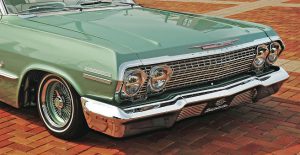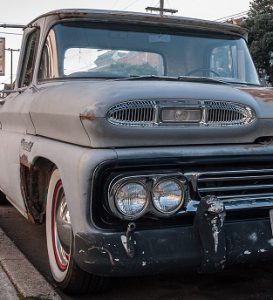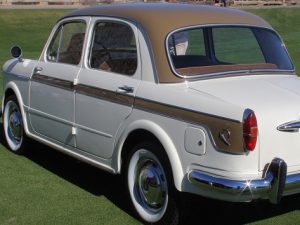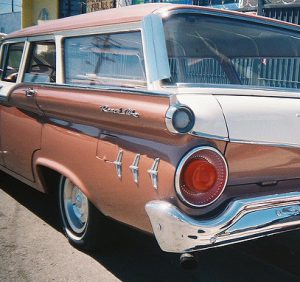On the way to the country club early on a Sunday morning, Izzy is picked up hitchhiking. From the opposite direction comes a 1965 Thunderbird.

I reeled in an old-timer. He remarked that he didn’t see many hitchhikers of a Sunday morning, and I said there weren’t many cars either, so maybe the world was in balance after all. Ahead of us, coming in our direction, was a 1965 Thunderbird, from the generation after Ford had begun stretching the model out. The driver’s left elbow was resting out the window. The T-Bird came at us fast and as we drew close the driver glanced in our direction and flicked a cigarette with his right hand, across his body, in our general direction, then flew on behind us.
“Sumbitch,” my ride muttered, automatically, as if he wasn’t thinking hard about it. I whirled around and saw the T-Bird, light blue with a white top, zoom away. There was no trace of a fin, just two wide banks of lights that narrowed over the license plate, with a scoop up the middle of the trunk.
The flick seemed intentional, a littering of opportunity. He may have seen us from a distance, as I had noticed him, and perhaps on a whim decided to shoot his cigarette butt at us.
The old guy who picked me up had a low opinion of golfers, and he didn’t mind sharing this with me. I couldn’t tell exactly whether he was putting me down for being part of the time-wasting, self-indulgent sect of golf, or whether he thought that I, as a caddy, must have shared his views. It turned out he wasn’t too fond of hippies, blacks, women’s libbers and homos.
In an abundance of caution, I did not bring up the Boy Scouts nor confess that I was a poverty protester who had escaped police custody and was in grave danger of enjoying modern poetry.
 Driving home from work, Izzy and Speedy come across a woman driving a 1963 Chevy Impala. She tosses her cigarette. When asked to explain why, she tells Izzy he’s too young to smoke.
Driving home from work, Izzy and Speedy come across a woman driving a 1963 Chevy Impala. She tosses her cigarette. When asked to explain why, she tells Izzy he’s too young to smoke. Izzy and Speedy confront a butt-flicker in a 1960 Chevrolet Apache on their way to work. It doesn’t go well.
Izzy and Speedy confront a butt-flicker in a 1960 Chevrolet Apache on their way to work. It doesn’t go well. Later, Izzy commits a hippie faux pas while riding with Juliana in a 1957 Dodge Regent to see the Fifth Dimension at the music circus outside of Lambertville.
Later, Izzy commits a hippie faux pas while riding with Juliana in a 1957 Dodge Regent to see the Fifth Dimension at the music circus outside of Lambertville. This date was a double-header in the AutoFlick chronology. Upon arriving in Washington, DC, to go to the Poor People’s Campaign, Izzy and Speedy see a man throw a cigarette from his 1960 Fiat 1100.
This date was a double-header in the AutoFlick chronology. Upon arriving in Washington, DC, to go to the Poor People’s Campaign, Izzy and Speedy see a man throw a cigarette from his 1960 Fiat 1100. Hitch-hiking home from work, Izzy gets a ride with girl from his high school who is driving her family’s 1959 Ford Fairlane Ranch Wagon. She throws her cigarette out the window as she rushes to make room for him in the front seat. It turns out better than he might have expected.
Hitch-hiking home from work, Izzy gets a ride with girl from his high school who is driving her family’s 1959 Ford Fairlane Ranch Wagon. She throws her cigarette out the window as she rushes to make room for him in the front seat. It turns out better than he might have expected.